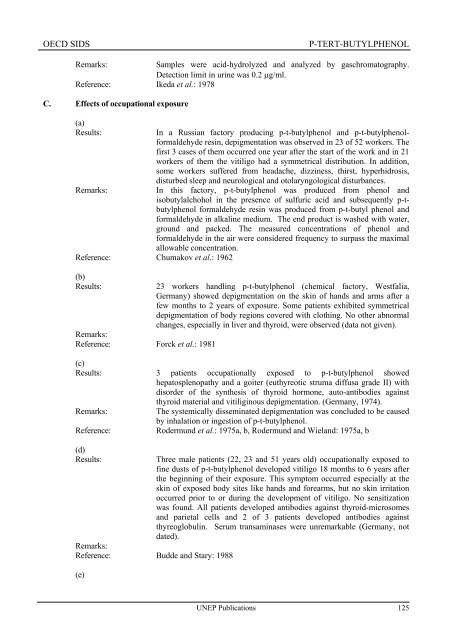p-Tert-Butylphenol - UNEP Chemicals
p-Tert-Butylphenol - UNEP Chemicals
p-Tert-Butylphenol - UNEP Chemicals
You also want an ePaper? Increase the reach of your titles
YUMPU automatically turns print PDFs into web optimized ePapers that Google loves.
OECD SIDS P-TERT-BUTYLPHENOL<br />
Remarks: Samples were acid-hydrolyzed and analyzed by gaschromatography.<br />
Detection limit in urine was 0.2 µg/ml.<br />
Reference: Ikeda et al.: 1978<br />
C. Effects of occupational exposure<br />
(a)<br />
Results: In a Russian factory producing p-t-butylphenol and p-t-butylphenolformaldehyde<br />
resin, depigmentation was observed in 23 of 52 workers. The<br />
first 3 cases of them occurred one year after the start of the work and in 21<br />
workers of them the vitiligo had a symmetrical distribution. In addition,<br />
some workers suffered from headache, dizziness, thirst, hyperhidrosis,<br />
disturbed sleep and neurological and otolaryngological disturbances.<br />
Remarks: In this factory, p-t-butylphenol was produced from phenol and<br />
isobutylalchohol in the presence of sulfuric acid and subsequently p-tbutylphenol<br />
formaldehyde resin was produced from p-t-butyl phenol and<br />
formaldehyde in alkaline medium. The end product is washed with water,<br />
ground and packed. The measured concentrations of phenol and<br />
formaldehyde in the air were considered frequency to surpass the maximal<br />
allowable concentration.<br />
Reference: Chumakov et al.: 1962<br />
(b)<br />
Results: 23 workers handling p-t-butylphenol (chemical factory, Westfalia,<br />
Germany) showed depigmentation on the skin of hands and arms after a<br />
few months to 2 years of exposure. Some patients exhibited symmetrical<br />
depigmentation of body regions covered with clothing. No other abnormal<br />
changes, especially in liver and thyroid, were observed (data not given).<br />
Remarks:<br />
Reference: Forck et al.: 1981<br />
(c)<br />
Results: 3 patients occupationally exposed to p-t-butylphenol showed<br />
hepatosplenopathy and a goiter (euthyreotic struma diffusa grade II) with<br />
disorder of the synthesis of thyroid hormone, auto-antibodies against<br />
thyroid material and vitiliginous depigmentation. (Germany, 1974).<br />
Remarks: The systemically disseminated depigmentation was concluded to be caused<br />
by inhalation or ingestion of p-t-butylphenol.<br />
Reference: Rodermund et al.: 1975a, b, Rodermund and Wieland: 1975a, b<br />
(d)<br />
Results: Three male patients (22, 23 and 51 years old) occupationally exposed to<br />
fine dusts of p-t-butylphenol developed vitiligo 18 months to 6 years after<br />
the beginning of their exposure. This symptom occurred especially at the<br />
skin of exposed body sites like hands and forearms, but no skin irritation<br />
occurred prior to or during the development of vitiligo. No sensitization<br />
was found. All patients developed antibodies against thyroid-microsomes<br />
and parietal cells and 2 of 3 patients developed antibodies against<br />
thyreoglobulin. Serum transaminases were unremarkable (Germany, not<br />
dated).<br />
Remarks:<br />
Reference: Budde and Stary: 1988<br />
(e)<br />
<strong>UNEP</strong> Publications 125
















